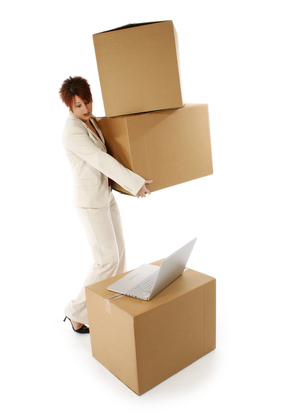Relocating a business is a confusing and stressful process for everyone who is involved. One of the parts of relocating is making the decision about what items should be taken to the new location and what items should be left behind. The expense of moving certain parts of an office or retail storefront often exceed the price of replacing the items. There are also situations where items are no longer needed or cannot be used at the new location. Businesses should consider how to handle a few types of items when moving.

Anything Containing Client Information
Absolutely nothing should be left behind that contains any proprietary information, data about clients or details of financial transactions. Even a small amount of information could become a security problem if it is not disposed of properly. Any furniture that is left behind should be checked to ensure that binders, reports or loose pieces of paper are not left in the drawers. Papers that are not needed should be disposed of properly at the new location or before the move through shredding or other document destruction methods.
Custom Fixtures And Furniture
Some storefronts and offices have acquired furniture and fixtures over the years that were custom designed to fit the space available. This could be a specially designed reception desk or a checkout counter that curves with the shape of the room. It is generally not worth the effort to take these types of custom units to a new location. This is mostly because the fixture will not fit or be usable in the new space.
Electronics And Information Technology Systems
All electronics should be taken when relocating. Computers, backup systems and presentation systems should all be packaged and moved to the new location. One reason is that there could be sensitive customer or business data stored in the devices. Electronics also tend to be costly to replace so the cost of moving a bank of servers or workstations is normally less than what it would cost to replace them.
Installed Fixtures
Businesses generally leave behind any installed fixtures. This includes lighting, networking ports and other wiring in the office or storefront. Many retail locations that are relocating will leave larger display fixtures behind such as a slatwall. Simple shelves are also usually left behind. This is frequently done because tearing out set fixtures will cause damage to the walls and the actual item being removed.
Merchandise
It is always a good idea in a sales or retail business environment to package and move every piece of merchandise in the store and to leave nothing behind. Companies often do this so that the next tenants or people who enter the space will not perceive that the merchandise has no value. Unwanted merchandise should either be moved and then disposed of through vendors or donated to local charities.
Parts Of The Building
Anything that is in the building because it is required by law should be left in place. This is means exit signs, smoke detectors and fire extinguishers. One exception is for businesses that have invested heavily in extra safety equipment. These items are normally left behind by previous tenants or installed during construction so that the appropriate signs and systems will already be in place at the new location.
This post was provided by Greg Peters, a business man with relocation experience. He suggest using moving companies London Ontario to help with your business move. He recommends the expert help from A-Zip Moving & Cartage.

